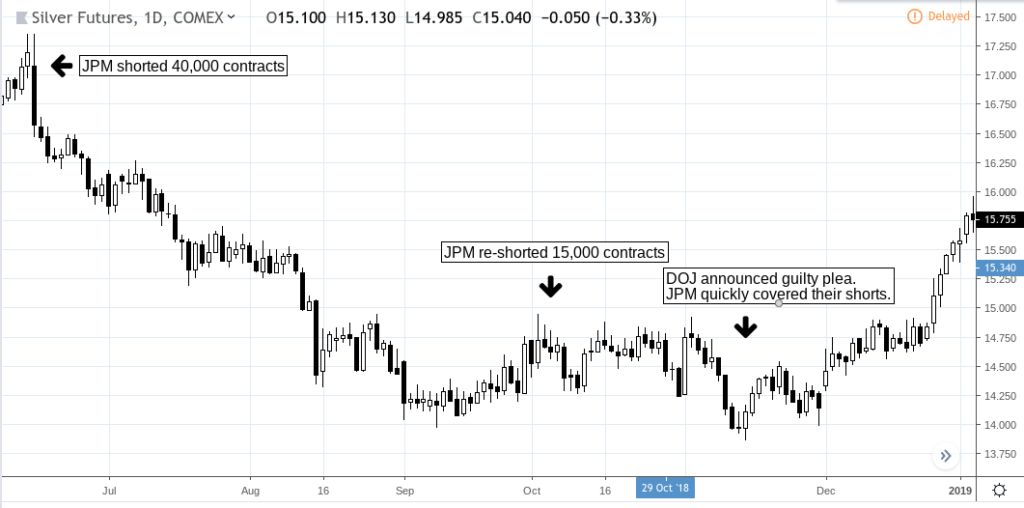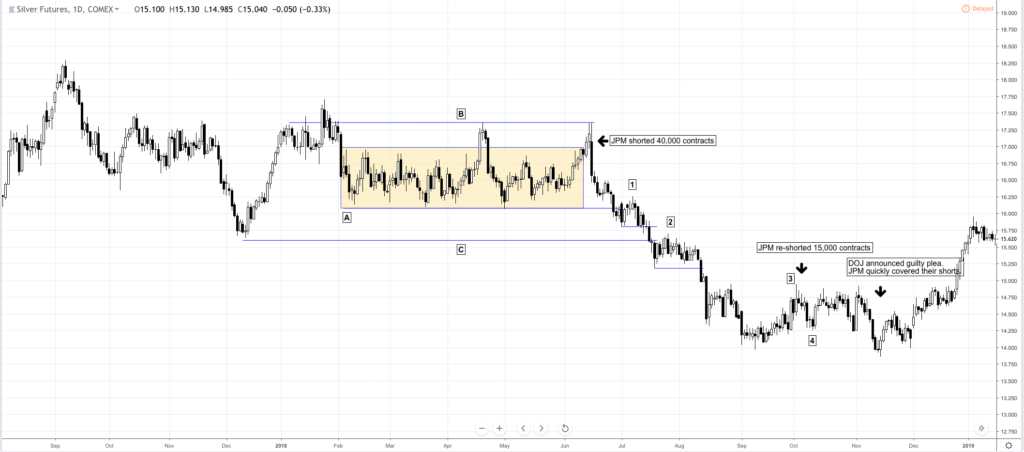A common complaint from many technical day traders & swing traders is that of “market manipulation.” Apparently, so the complaint goes, either the fundamentals or technicals appear to give a clear indication of price, up until a relatively large “whale” steps in with massive buy or sell orders to ruin what at first looked like an ideal trade.
In highly liquid and efficient markets, such manipulative schemes are hard to pull off. In less-liquid and less-efficient markets, however, it may be easier (if you’ve ever tried trading a penny stock, you probably know what we mean).
Manipulations in the Silver Market?
On November 6, 2018, the Department of Justice (DOJ) announced the guilty plea of a former JPMorgan trader for fraudulent and manipulative practices spanning six years in the precious metals market.
If you did not follow this news story, here’s some background info to bring you up to speed:
When Bear Stearns failed in 2008, JPM absorbed them in a merger for $2 a share. One thing that JPM acquired from this merger was a massive short position on silver, which they have kept more or less to this day.
Whether it be truth or conspiracy theory, JPM is alleged to have one of the largest silver holdings across the globe.
JPM’s strategy appears to be:
- Laying down massive shorts on COMEX silver futures to bring prices down; and
- Accumulating physical silver at discount prices.
Simple, perhaps brilliant, but certainly questionable.
JPM’s Alleged 40,000-Contract Short
On a number of gold sites, you’ll hear that JPM was short 40,000 COMEX silver futures contracts in June 2018. They covered their positions in September (where thy might have acquired more of the physical bullion), and re-shorted 15,000 contracts in October only to quickly close their shorts a month later, when the November 6, DOJ announced the ex-JPM trader’s guilty plea.
This is what its alleged manipulative effect looks like on a price chart:
COMEX Silver Futures (SI continuous contract) Daily chart from 6/8/18 to 1/4/19

Trading an Allegedly “Manipulated” Market
Let’s suppose the alleged manipulation is true, and that you were caught unaware of the 40,000 contract short in the silver futures. Would it have made a difference, if you were swing trading silver, and if your only outlook was technical?
COMEX Silver Futures (SI continuous contract) Daily chart from 8/7/17 to 1/16/19

Before the “big short,” you might have noticed the trading range (A) enveloped within a larger range with relative resistance at (B) and deeper potential support at (C).
The fact that price couldn’t seem to break above (B) might have indicated that the back-and-forth trading within the range might continue.
But instead, price broke below the smaller range support at (A).
Now you might have thought, “will price test support at (C)? If so, might it make a good profit target to go short? The reaction at (1) might have indicated a relatively safe entry point, as you’d place a stop right above the swing high, which was much closer resistance than (B).
If you got in at or above the breakdown, you’d notice that it didn’t just test (C), it fell below it, setting up another potential entry (to add more or to get in for the first time) at (2).
By the time price broke below this point, hopefully you might have been in a short position. Price’s retesting of the swing high at (3), which was quite high for a downtrending movement, and its failure at (4) to break below the last swing low indicated that a trend change or reversal may be taking place.
This is the “story” that the technicals might tell, in parallel with the narrative of alleged JPM price manipulation.
The Takeaway
Most gold and silver traders invest for the long haul. They tend to follow “sound money” ideology, not fleeting opportunities. Many (perhaps most) of them are not proficient in technical analysis as it doesn’t suit their investment style of outlook.
But without technical knowledge, market manipulation, or rumors of manipulation, can make it very difficult for these investors to plot when and where to buy or sell.
As you can see, technical price action gives you its own story of supply and demand. And since technical analysis is geared toward action, that story comes with tactical opportunities (sometimes right, sometimes wrong…but opportunities nevertheless).
Manipulated market or not, a relatively-efficient market with enough liquidity might provide you with enough technical clues to make such a market tradable.
A massive buy or sell might take you by surprise, which is why following the fundamentals might be the most you can do to see price movement clearly enough to make intelligent and informed trading decisions.
Please be aware that the content of this blog is based upon the opinions and research of GFF Brokers and its staff and should not be treated as trade recommendations. There is a substantial risk of loss in trading futures, options and forex. Past performance is not necessarily indicative of future results.
Be advised that there are instances in which stop losses may not trigger. In cases where the market is illiquid–either no buyers or no sellers–or in cases of electronic disruptions, stop losses can fail. And although stop losses can be considered a risk management (loss management) strategy, their function can never be completely guaranteed.
Disclaimer Regarding Hypothetical Performance Results: HYPOTHETICAL PERFORMANCE RESULTS HAVE MANY INHERENT LIMITATIONS, SOME OF WHICH ARE DESCRIBED BELOW. NO REPRESENTATION IS BEING MADE THAT ANY ACCOUNT WILL OR IS LIKELY TO ACHIEVE PROFITS OR LOSSES SIMILAR TO THOSE SHOWN. IN FACT, THERE ARE FREQUENTLY SHARP DIFFERENCES BETWEEN HYPOTHETICAL PERFORMANCE RESULTS AND THE ACTUAL RESULTS SUBSEQUENTLY ACHIEVED BY ANY PARTICULAR TRADING PROGRAM.
ONE OF THE LIMITATIONS OF HYPOTHETICAL PERFORMANCE RESULTS IS THAT THEY ARE GENERALLY PREPARED WITH THE BENEFIT OF HINDSIGHT. IN ADDITION, HYPOTHETICAL TRADING DOES NOT INVOLVE FINANCIAL RISK, AND NO HYPOTHETICAL TRADING RECORD CAN COMPLETELY ACCOUNT FOR THE IMPACT OF FINANCIAL RISK IN ACTUAL TRADING. FOR EXAMPLE, THE ABILITY TO WITHSTAND LOSSES OR TO ADHERE TO A PARTICULAR TRADING PROGRAM IN SPITE OF TRADING LOSSES ARE MATERIAL POINTS WHICH CAN ALSO ADVERSELY AFFECT ACTUAL TRADING RESULTS. THERE ARE NUMEROUS OTHER FACTORS RELATED TO THE MARKETS IN GENERAL OR TO THE IMPLEMENTATION OF ANY SPECIFIC TRADING PROGRAM WHICH CANNOT BE FULLY ACCOUNTED FOR IN THE PREPARATION OF HYPOTHETICAL PERFORMANCE RESULTS AND ALL OF WHICH CAN ADVERSELY AFFECT ACTUAL TRADING RESULTS.